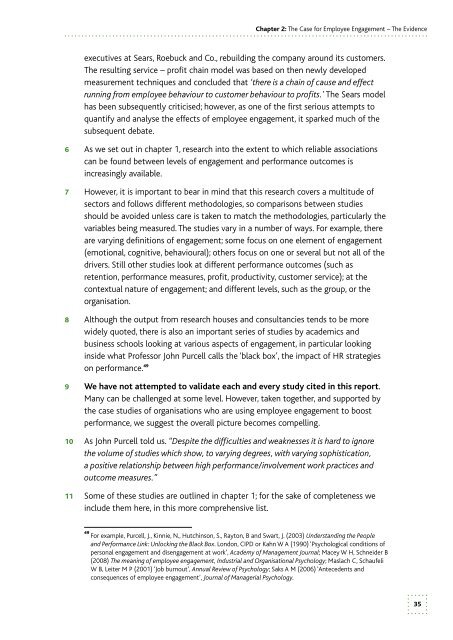3ytgeaf
3ytgeaf
3ytgeaf
You also want an ePaper? Increase the reach of your titles
YUMPU automatically turns print PDFs into web optimized ePapers that Google loves.
Chapter 2: The Case for Employee Engagement – The Evidence<br />
executives at Sears, Roebuck and Co., rebuilding the company around its customers.<br />
The resulting service – profit chain model was based on then newly developed<br />
measurement techniques and concluded that ‘there is a chain of cause and effect<br />
running from employee behaviour to customer behaviour to profits.’ The Sears model<br />
has been subsequently criticised; however, as one of the first serious attempts to<br />
quantify and analyse the effects of employee engagement, it sparked much of the<br />
subsequent debate.<br />
6 As we set out in chapter 1, research into the extent to which reliable associations<br />
can be found between levels of engagement and performance outcomes is<br />
increasingly available.<br />
7 However, it is important to bear in mind that this research covers a multitude of<br />
sectors and follows different methodologies, so comparisons between studies<br />
should be avoided unless care is taken to match the methodologies, particularly the<br />
variables being measured. The studies vary in a number of ways. For example, there<br />
are varying definitions of engagement; some focus on one element of engagement<br />
(emotional, cognitive, behavioural); others focus on one or several but not all of the<br />
drivers. Still other studies look at different performance outcomes (such as<br />
retention, performance measures, profit, productivity, customer service); at the<br />
contextual nature of engagement; and different levels, such as the group, or the<br />
organisation.<br />
8 Although the output from research houses and consultancies tends to be more<br />
widely quoted, there is also an important series of studies by academics and<br />
business schools looking at various aspects of engagement, in particular looking<br />
inside what Professor John Purcell calls the ‘black box’, the impact of HR strategies<br />
on performance. 49<br />
9 We have not attempted to validate each and every study cited in this report .<br />
Many can be challenged at some level. However, taken together, and supported by<br />
the case studies of organisations who are using employee engagement to boost<br />
performance, we suggest the overall picture becomes compelling.<br />
10 As John Purcell told us. “Despite the difficulties and weaknesses it is hard to ignore<br />
the volume of studies which show, to varying degrees, with varying sophistication,<br />
a positive relationship between high performance/involvement work practices and<br />
outcome measures.”<br />
11 Some of these studies are outlined in chapter 1; for the sake of completeness we<br />
include them here, in this more comprehensive list.<br />
49<br />
For example, Purcell, J., Kinnie, N., Hutchinson, S., Rayton, B and Swart, J. (2003) Understanding the People<br />
and Performance Link: Unlocking the Black Box. London, CIPD or Kahn W A (1990) ‘Psychological conditions of<br />
personal engagement and disengagement at work’, Academy of Management Journal; Macey W H, Schneider B<br />
(2008) The meaning of employee engagement, Industrial and Organisational Psychology; Maslach C, Schaufeli<br />
W B, Leiter M P (2001) ‘Job burnout’, Annual Review of Psychology; Saks A M (2006) ‘Antecedents and<br />
consequences of employee engagement’, Journal of Managerial Psychology.<br />
35


